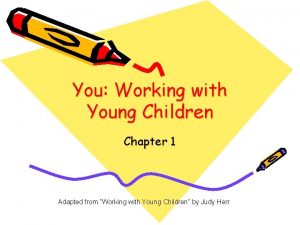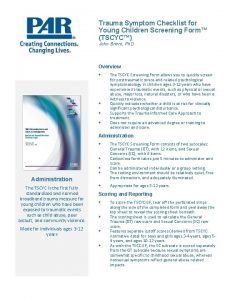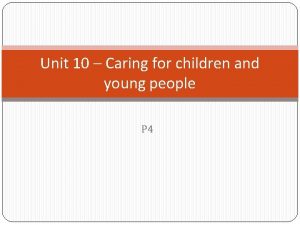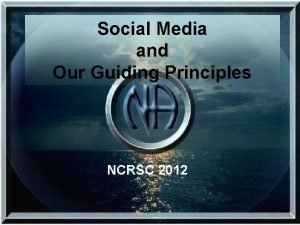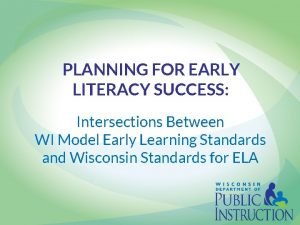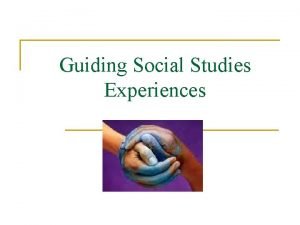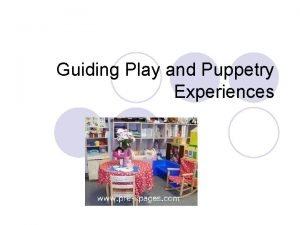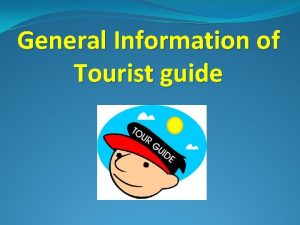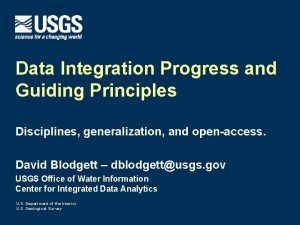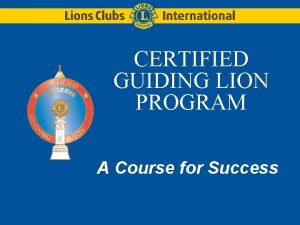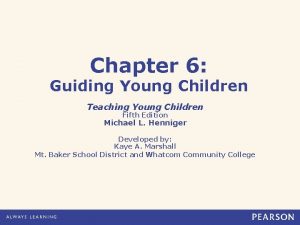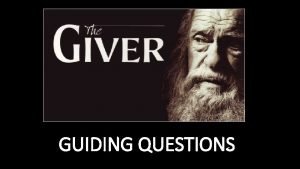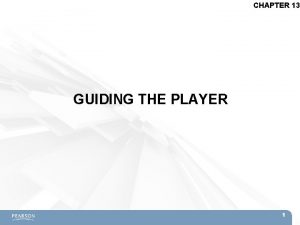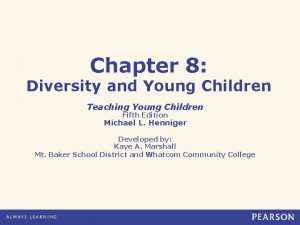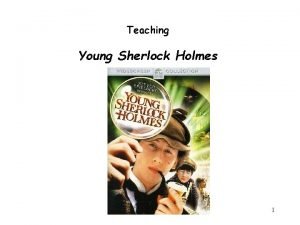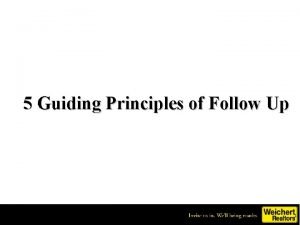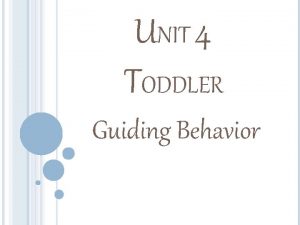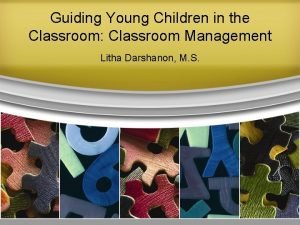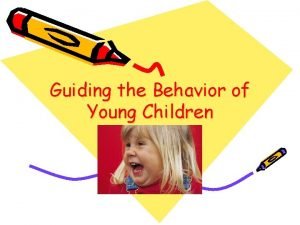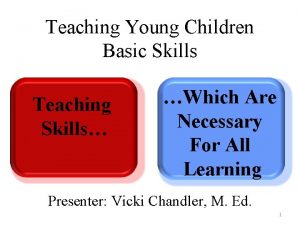Chapter 6 Guiding Young Children Teaching Young Children


























- Slides: 26

Chapter 6 Guiding Young Children Teaching Young Children, 4 th Edition © 2009 Pearson Education, Inc. All rights reserved.

Goals of Chapter 6 n n n Define guidance and differentiate it from discipline Study basic principles of guidance Develop strategies to assist children in understanding and responding to their feelings Understand the importance of routines in early childhood classrooms, and learn how to deal with them Identify techniques for guiding social interactions Learn to guide groups of children Teaching Young Children, 4 th Edition Henniger 2 © 2009 Pearson Education, Inc. All Rights Reserved.

What is Guidance? n n Guidance is a broad concept, incorporating all the adult does to influence the behavior of a child Discipline is an important component of the guidance process in which the adult is dealing with children who misbehave Teaching Young Children, 4 th Edition Henniger 3 © 2009 Pearson Education, Inc. All Rights Reserved.

Building Self-Esteem n n Self-esteem is a psychological concept referring to a person’s assessment of abilities and skills 3 dimensions of self-esteem n n n Competence – a belief that you can accomplish tasks and achieve goals Worth – the extent to which you value yourself Control – the degree to which people feel they can influence the events around them Teaching Young Children, 4 th Edition Henniger 4 © 2009 Pearson Education, Inc. All Rights Reserved.

Supporting Emotional and Social Development n Teacher should: n n Guide children in relating with each other Help children identify feelings, provide labels for them Teach appropriate ways to manage emotions Regularly take time to assist in this process Teaching Young Children, 4 th Edition Henniger 5 © 2009 Pearson Education, Inc. All Rights Reserved.

Growing Toward Independence and Self-Control n n n Use guidance to help children make proper decisions Understand that independence and self-control can develop slowly Guide children in managing anger and frustrations Step back and let children work things out for themselves Remain calm and deal with own feelings Models appropriate behaviors for children Teaching Young Children, 4 th Edition Henniger 6 © 2009 Pearson Education, Inc. All Rights Reserved.

Rules with Young Children n n n Keep list of rules short Make your rules positive statements (do’s instead of don’t’s) Use rules to preserve dignity by being supportive instead of harsh Apply to adults too Make sure the children understand the rules and expectations Identify consequences for breaking rules Teaching Young Children, 4 th Edition Henniger 7 © 2009 Pearson Education, Inc. All Rights Reserved.

Recognize Feelings and Understand Emotions n n Accept feelings as valid Be calm and direct Help child verbalize emotions Suggest alternatives Teaching Young Children, 4 th Edition Henniger 8 © 2009 Pearson Education, Inc. All Rights Reserved.

Guidance Strategies n Initial considerations n n n Teaching Young Children, 4 th Edition Henniger Each child is unique Every situation is unique Every teacher is unique 9 © 2009 Pearson Education, Inc. All Rights Reserved.

Indirect Guidance n n Carefully plan daily schedule to meet the interest and abilities of children Arrange classroom space so there are clues to help children know what to do there Plan activities that are varied and exciting Activities should invite participation Teaching Young Children, 4 th Edition Henniger 10 © 2009 Pearson Education, Inc. All Rights Reserved.

Indirect Guidance (continued) n n Provide materials that are safe and can be used with minimum help Store materials you do not want children to use out of sight Observe children to develop an understanding of each child’s behaviors and needs Talk to parents to gain a deeper understanding Teaching Young Children, 4 th Edition Henniger 11 © 2009 Pearson Education, Inc. All Rights Reserved.

Building Relationships n n Establish strong working relationships with the children and their families Create an atmosphere of cooperation and support Teaching Young Children, 4 th Edition Henniger 12 © 2009 Pearson Education, Inc. All Rights Reserved.

Physically Guiding Children n n n Positive touching (putting on a band-aid or cleaning a hurt) Hugs Staying close to a child who needs assistance Gesturing and body language Taking them by the hand leading them to an appropriate activity High-fives, handshakes, pat on the back Teaching Young Children, 4 th Edition Henniger 13 © 2009 Pearson Education, Inc. All Rights Reserved.

Verbal Guidance Strategies n n n Active listening Redirection Validation Strengthening Verbal Communication n n Get down to the child’s level, speak quietly & directly Place the action words at the beginning Give directions at the time and place you want behavior to occur Give logical and accurate reasons for requests Keep competition to a minimum Teaching Young Children, 4 th Edition Henniger 14 © 2009 Pearson Education, Inc. All Rights Reserved.

Discipline Strategies n I-messages n n n I feel… when… Natural Consequences – “put your coat on, or it will be cold” Logical Consequences – “we walk in the hallway” if a child runs, have them go back and walk Teaching Young Children, 4 th Edition Henniger 15 © 2009 Pearson Education, Inc. All Rights Reserved.

Behavior Modification n 3 basic techniques n n n Teaching Young Children, 4 th Edition Henniger Positive reinforcement (smiles, highfives, praise) Punishment (without physical contact, humiliation or intimidation) Ignoring (in attention-seeking behavior) 16 © 2009 Pearson Education, Inc. All Rights Reserved.

Problem-Solving Strategies n n n Work together to identify the problem behavior Discuss the implications of the behavior Brainstorm possible solutions Agree on a plan Check to make sure the plan is working Teaching Young Children, 4 th Edition Henniger 17 © 2009 Pearson Education, Inc. All Rights Reserved.

Guiding Routines n Arrival and departure n n Welcome children and parents Take time to summarize the child’s day to bring closure Help them leave with a good feeling of the day Transitions n Children need clear expectations for transitions Teaching Young Children, 4 th Edition Henniger 18 © 2009 Pearson Education, Inc. All Rights Reserved.

Guiding Transitions n Snack and Meal Time n n Toileting n n Should foster independence and be social Talking, singing and playing games in diapering Develop consistent toileting routines Have a casual, calm approach Rest Time n n n Consistent routines Matter of fact attitude Back rubs, soft music or singing, reading books, and quiet conversation sometimes help when difficulties arise, yet keep in mind that learning to fall asleep alone is a skill that should be encouraged Teaching Young Children, 4 th Edition Henniger 19 © 2009 Pearson Education, Inc. All Rights Reserved.

Guiding Social Interactions n Goals include: n Showing sympathy and kindness n Demonstrating helping n Accepting food or toys n Engaging in sharing n Showing positive verbal and physical interactions n Comforting others in distress n Exhibiting concerns n Taking the perspective of others n Demonstrating affection Teaching Young Children, 4 th Edition Henniger 20 © 2009 Pearson Education, Inc. All Rights Reserved.

How can teachers facilitate these goals? Be a careful observer n Encourage children to solve their own problems n Define limits of acceptable behavior n Teaching Young Children, 4 th Edition Henniger 21 © 2009 Pearson Education, Inc. All Rights Reserved.

Help Children Become More Prosocial n n n n Emphasize cooperation, not competition Teach cooperative games and sports Set up the environment to promote cooperative play Select literature that promotes prosocial behaviors Lead discussions that deal with positive social interactions Include projects that provide opportunities for children to help others Invite adults who have helped others in the community to talk about their experiences with the children Teaching Young Children, 4 th Edition Henniger 22 © 2009 Pearson Education, Inc. All Rights Reserved.

Group Guidance n n Careful planning and preparation Consider the physical setting Mixing active and quiet times Flexibility Teaching Young Children, 4 th Edition Henniger 23 © 2009 Pearson Education, Inc. All Rights Reserved.

Guidance for Children with Special Needs n n n Guidance strategies discussed in this chapter can be used Plan carefully for implementation of strategies Work closely with parents Teaching Young Children, 4 th Edition Henniger 24 © 2009 Pearson Education, Inc. All Rights Reserved.

Observing Development – Childhood Emotions n Observe n n Reflect n n Go to My. Education. Lab and select “Classroom Management” and watch the video “Empowering Students to Resolve Conflicts”. How effective was the teacher in this video? Apply n Identify the steps the teacher took to assist children in resolving their own conflicts? Teaching Young Children, 4 th Edition Henniger 25 © 2009 Pearson Education, Inc. All Rights Reserved.

Multimedia Exploration and Activities… n Research n n Reflect n n Go to My. Education. Lab and select “Guidance” then read “The Conflict Resolution Process”. How can you as a future teacher help facilitate conflict resolution among children? Respond n Plan a “Conflict Resolution” workshop for your classmates, using the guidelines at the end of this chapter in your textbook. Teaching Young Children, 4 th Edition Henniger 26 © 2009 Pearson Education, Inc. All Rights Reserved.
 End goals of mtb-mle
End goals of mtb-mle Working with young children/answer key chapter 1
Working with young children/answer key chapter 1 Chapter 20 guiding storytelling experiences
Chapter 20 guiding storytelling experiences Teaching children joy
Teaching children joy Microteaching meaning
Microteaching meaning Trauma symptom checklist for young children
Trauma symptom checklist for young children Phonemic awareness in young children
Phonemic awareness in young children Sfyc hampshire
Sfyc hampshire Unit 10 caring for children and young people
Unit 10 caring for children and young people Young children are particularly sensitive to ets
Young children are particularly sensitive to ets How to teach grammar to young learners
How to teach grammar to young learners Teaching young learners english
Teaching young learners english Guiding barrier
Guiding barrier Occlusal rest
Occlusal rest Priority of sendai framework
Priority of sendai framework Na guiding principals
Na guiding principals Wmels domains
Wmels domains Laws guiding book publishing in nigeria
Laws guiding book publishing in nigeria Introduction of ncf 2005
Introduction of ncf 2005 Mcpon guiding principles 2021
Mcpon guiding principles 2021 Importance of social studies
Importance of social studies Guiding play and puppetry experiences
Guiding play and puppetry experiences Guide plane in rpd
Guide plane in rpd Objectives of tour guiding
Objectives of tour guiding Evolution of eia
Evolution of eia Integration guiding principles
Integration guiding principles Guiding lion
Guiding lion

